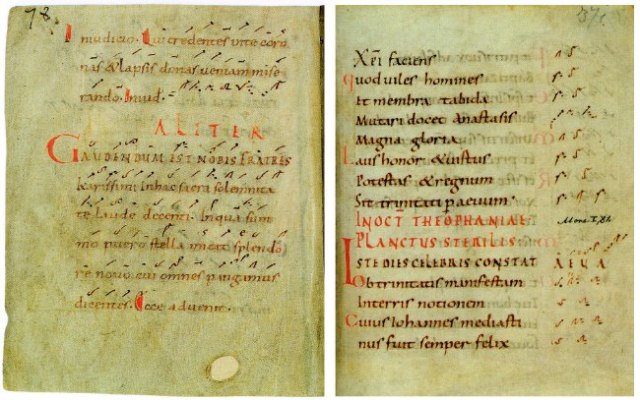By Jenny Weston
As a researcher studying the reading habits of medieval monks, I spend a great deal of time pondering the ‘world of the monk’. While I usually focus on the books that the monks were reading, I cannot help but wonder what it was like to live in a monastery in general. Was it cold? Warm? How was the food? What did it feel like to wake up in the middle of the night to pray? And — most importantly for today’s post — what did it sound like?
Some of the most beautiful and intriguing medieval manuscripts that I have looked at are liturgical books that contain music — antiphonaries, graduals, breviaries, and missals.
These books were designed to help guide a monastic community through the daily rituals of the Office and Mass and were typically filled with prayers, chants, and hymns. Since such liturgical manuscripts were staples of the monastic library, they typically survive in large numbers, and some modern scholars have accused them of being — heaven forbid — rather “boring”.
But what I love about these manuscripts is that we can not only read the texts, but we can also listen to them. We can hear the same melodies and harmonies that once echoed off the walls of the medieval cloister. In the following video, we can listen to one such late-medieval chant being performed by a small group of male singers (‘Psallentes’) from the original manuscript (E-BC 911).
The way that the music was presented on the page is also interesting. Just like other forms of medieval script, we can see that musical notation was subject to change over time. Some of the earliest forms of musical notation can be found in liturgical manuscripts from the ninth century, where the most popular form of notation was known as the neume system — typically consisting of small lines and dots written above the words of a chant or hymn (written without staff lines and fairly limited in detail).
Here we can see an example of neumes in two 10th-century manuscripts containing ‘tropes’ (short pieces of music added to pre-existing chants):
Over time, the music became more complex, and the scribes who copied these songs were faced with a greater challenge of accurately presenting the music on the page. By the twelfth and thirteenth centuries, scribes more frequently added staff lines, key signatures, and rhythm, and gradually shifted to a more detailed form of notation, known as square notation. All of these additional features, would help indicate to the singers how, where, and when to sing each specific part.
I also found it interesting to learn that music was typically taught orally, and, for the most part, performed from memory (similar to the way that monks would learn the psalms by heart from a young age). Books that contained music then, were often used only as a basic guide for the choir master, which is evident from the fact that most of the words in the book are abbreviated and the notation is still relatively simplistic. Such books also serve as a recorded copy of the rituals of the community, an important means for maintaining liturgical traditions, and a unique way for us to hear the sounds of the medieval world.




